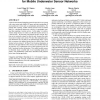Free Online Productivity Tools
i2Speak
i2Symbol
i2OCR
iTex2Img
iWeb2Print
iWeb2Shot
i2Type
iPdf2Split
iPdf2Merge
i2Bopomofo
i2Arabic
i2Style
i2Image
i2PDF
iLatex2Rtf
Sci2ools
JSAC
2010
2010
Phero-trail: a bio-inspired location service for mobile underwater sensor networks
A SEA Swarm (Sensor Equipped Aquatic Swarm) moves as a group with water current and enables 4D (space and time) monitoring of local underwater events such as contaminants and intruders. For prompt alert reporting, mobile sensors forward events to mobile sinks (i.e., autonomous underwater vehicles) via geographic routing, thus requiring a location service. In this paper, we analyze various design choices to realize an efficient location service in a SEA Swarm. We find that conventional ad hoc network location service protocols cannot be directly used, because the entire swarm moves along water current. We show that maintaining location information in a 2D plane is an optimal design choice. Given this, we propose a bio-inspired location service called a Phero-Trail location service protocol. In Phero-Trail, location information is stored in a 2D upper hull of a SEA Swarm, and a mobile sink uses its trajectory (à la a pheromone trail of ants) projected to the 2D hull to maintain locat...
| Added | 29 Jan 2011 |
| Updated | 29 Jan 2011 |
| Type | Journal |
| Year | 2010 |
| Where | JSAC |
| Authors | Luiz Filipe M. Vieira, Uichin Lee, Mario Gerla |
Comments (0)

